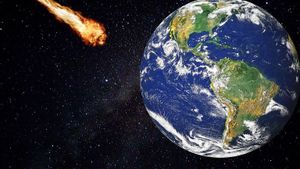JAKARTA - Climate scientists in the United States (USA), stated recently that 2021 is one of the hottest years on record.
According to NASA and the National Oceanic and Atmospheric Administration (NOAA), the average global surface temperature is the sixth warmest, making the last eight years the warmest in more than 140 years.
Temperatures in 2021 will be almost 2 degrees Fahrenheit (about 1.1 Celsius) hotter than the average temperature in the late 19th century. But most importantly, climate scientists emphasize that it is the long-term temperature trends that really matter and best describe how global surface temperatures are changing.
"It's the long-term effects on climate that we're really concerned about. It's very clear that temperatures are rising, and they are rising rapidly," said Zeke Hausfather, a climate scientist and researcher at the environmental science organization Berkeley Earth.
Amid rising global temperatures, there are recurring short-term climate patterns that signal even greater warming. The pattern is most influential in the Pacific Ocean, which can see periods of sea level warming (El Niño) or cooling (La Niña) from year to year. These events temporarily push the overall global temperature up or down.
"It's very clear that temperatures are rising, and they are rising rapidly. We live on a dynamic planet with lots of daily, weekly, monthly, and yearly fluctuations. If you're looking for long-term change, you have to average over the long term," said an environmental chemist at Michigan Technological University who was not involved with the 2021 climate report, Sarah Green.
Responding to Green's statement, Hausfather agreed, "Focusing on short-term variability is not very helpful," he stressed.
The temperature that continues to rise at this time is not surprising. Human activities on a large scale, especially the burning of fossil fuels have driven important changes in the atmosphere.
For example, levels of the most important greenhouse gas, carbon dioxide, are now the highest in about 3 million years and are still rising. Every year, humanity emits large amounts of carbon into the atmosphere.
In fact, the impacts of climate change will only grow until countries reduce their carbon emissions to around zero. But every year, attempts to limit warming to about 2 Celsius above 19th-century levels are getting scarier. The solutions are such as expansion of farmland, strong sea breeze, and adoption of electric vehicles.
SEE ALSO:
Here are some of the impacts of climate change if we don't implement the solution quickly, as quoted from Mashable, Friday, January 14.
1. Extreme Fire
Rising temperatures and droughts make vegetation dry and allow wildfires to burn faster, significantly contributing to wildfires and extreme urban firestorms.
2. Flash Flood
A warmer climate allows the atmosphere to hold more water. This increases the chances of more severe and record-breaking flooding.
3. Unstable Ice Sheet
Warmer ocean waters have destabilized the Florida-sized Thwaites Glacier. It recedes again, if it collapses it could eventually raise sea levels in the next few centuries.
4. Ocean Warming
The oceans absorb more than 90 percent of the human heat trapped on Earth. That's an almost unexpected number. This signals continued sea-level rise, major disturbances to animal life, and so on. Ocean heat reaches a record high in 2021.
5. More Diseases Are Transmitted
As the climate warms, the creatures that infect us with pathogens (vectors like mosquitoes and ticks) will spread.
The English, Chinese, Japanese, Arabic, and French versions are automatically generated by the AI. So there may still be inaccuracies in translating, please always see Indonesian as our main language. (system supported by DigitalSiber.id)

















